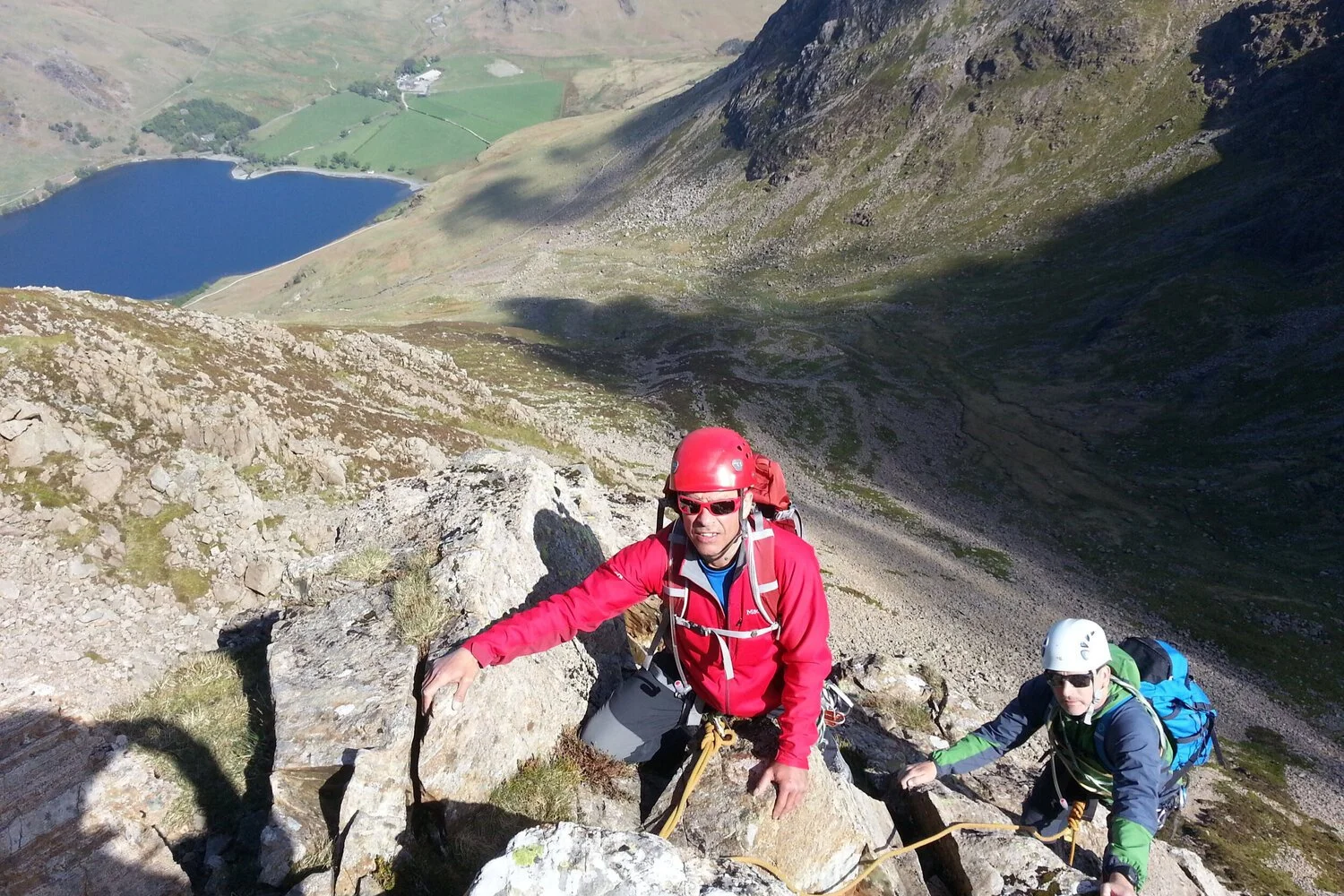The Ultimate Guide to Scrambling For Beginners in the UK
Have you ever been hill walking and found the need to use your hands to help you summit a mountain? If the answer is yes, then you have already experienced Scrambling.
In this complete beginners guide to Scrambling, we will dive into the basics of what it is and answer some of your questions.
How is Scrambling different from Climbing?
Scrambling:
Scrambling involves moving through steep terrain with the use of your hands.
It can be described as the middle ground between walking and climbing and is graded from 1 to 3.
Grade one is much like an exposed walking route, whereas a grade three may be found in climbing guides described as moderate climbing, meaning that use of a rope could be required for some sections.
Many people believe that Scrambling is safer than rock climbing - however, this is not the case. It can be even more dangerous, especially on more challenging routes, as people often use less protective equipment when scrambling.
Climbing:
Climbing is ascending more vertical areas like cliffs, rocks and mountain ridges involving constant use of your feet and hands. It requires you to have significant upper body strength as in some places; your whole body weight could be held only through your hands and arms.
Five Basics
Before you set off for the first time here are the five basic principles you should know.
Research - Make sure that you know what grade you will be tackling and ensure that you have a rough idea of the direction you are taking by looking in a guide book.
Safety Equipment - Make sure that you have a good pair of boots. You will really notice the difference on steeper sections.
Test handholds and foot placements before entirely trusting your weight onto them.
Don't rush. Take it slow and enjoy the journey. You are more likely to make a mistake or go the wrong way if you are in a hurry.
Find out if there is an easier walking path for the way down. If you find it difficult on the way up, you are likely to struggle more when down-climbing.
Striding Edge, Helvellyn, Lake District.
How fit do I need to be for Scrambling?
If you have a good fitness level and are experienced in waking hills, you shouldn’t find basic Scrambling too tricky. You will also find that scrambles often have alternative ways up and down, giving you the option to skip the more difficult sections. This way, you can decide how much you want to challenge yourself.
Advanced level scrambling is much more exposed, with steep rock faces and high drops. As these are much more demanding, you will need a higher level of fitness, knowledge and confidence in using climbing equipment and a good head for heights.
Is Scrambling Dangerous?
The short answer here is absolutely yes. Many people believe that Scrambling is a safer version of rock climbing however, this is not the case. In fact, it can be a whole lot more dangerous as people often undertake scrambling with much less safety equipment than climbers.
Would you like to give it a go? Before you do, you must understand the grading system.
What are Scrambling Grades?
Scrambles are graded based on the level of difficulty and the skills which are required to complete them. Essentially the higher the number, the more complex and exposed the journey will be. It is crucial that you do not try a too difficult grade to begin with, as it can be challenging to get back down if you start to struggle.
Grade One
Most grade one's can be categorised as easier scrambles while still including some high, adrenaline fuelling sections. It is important to remember to take things slowly if it is your first grade one. Sturdy walking boots and appropriate clothing are essential.
Grade Two
Grade two is often described as a combination of scrambling and rock climbing. You may find yourself with some, particularly steep rock sections to climb. Exposure is also a lot more daring on a grade two; therefore knowledge and confidence in climbing is essential, and you may even need to use ropes for safety.
Grade Three
To put it simply. Grade 3 are much more challenging scrambles. Do not attempt one unless you have gained experience and confidence through one and two.
A grade 3 can often be described as moderate climbing - essentially the most accessible level of climbing. You can expect to be climbing some incredibly steep and exposed sections of rock, which will require the use of ropes.
What equipment do I need for Scrambling?
Scrambling is a very accessible activity. You most likely already have most of the equipment needed for your first scramble. However, if you wish to take on a higher grade, you will need specific safety equipment.
Basic - Grade 1
A guide book - This will help with route finding. You will not find scrambling routes signposted in the UK. There are usually several different paths you can take to reach the summit. A guide book will let you know the grade and ensure you do not find yourself on a tricky section.
Breathable and waterproof jacket and trousers - Being exposed on a mountain, the weather can be unpredictable. A good quality jacket and trousers should keep you warm and dry.
Trousers - A comfortable pair of walking trousers which will allow you freedom of movement.
Hiking boots - A good pair of boots is essential. If you already have a decent pair, you can use these.
In addition to the above you should take all the usual equipment that you take with you on a walk.
Map and the knowledge of how to use it
Compass
Spare warm layer
Wicking base layers
First aid kit
Water
Food
Good rucksack
Mobile Phone
Advanced - GRADE 2 AND 3 ROUTES
Harness - Ensure you have a fully certified rock climbing harness.
Helmet - We highly recommend that you wear a helmet when tackling grade 2 or 3.
Rope - A 50m single rope will usually provide a more than adequate length for scrambles up to grade 3.
Rack of climbing protection - These act as anchors attached to the rock face in case of a fall. Essential equipment includes cams/hexes, slings, extenders and carabiners.
Scrambling With Ropes
After ticking off the low difficulty scrambles, why not take your skills up a notch? Now's the time to think about using ropes.
Using a rope takes experience and expertise and can be complex if you do not have the required skills. The best way for you to gain knowledge is from a scrambling or private guiding course.
Where can I find beginner Scrambles in the UK?
Are you ready to transition from a walker into a scrambler? The UK has numerous great places to start. Here are a couple we recommend.
Red Brook, Kinder Scout - The Peak District
Great for beginners, Red brook is one of the best grade 1 scrambles to get started on.
Striding Edge, Helvellyn - The Lake District
Amazing views of the Lake District are visible from striding edge, however be sure to take extra care in wet weather conditions.
Our bespoke scrambling courses are designed to improve your skills and confidence.
Whether you are just starting out or wanting to master some more challenging terrain, book a scrambling course with Mammut Mountain School and take the first step on your next adventure.





